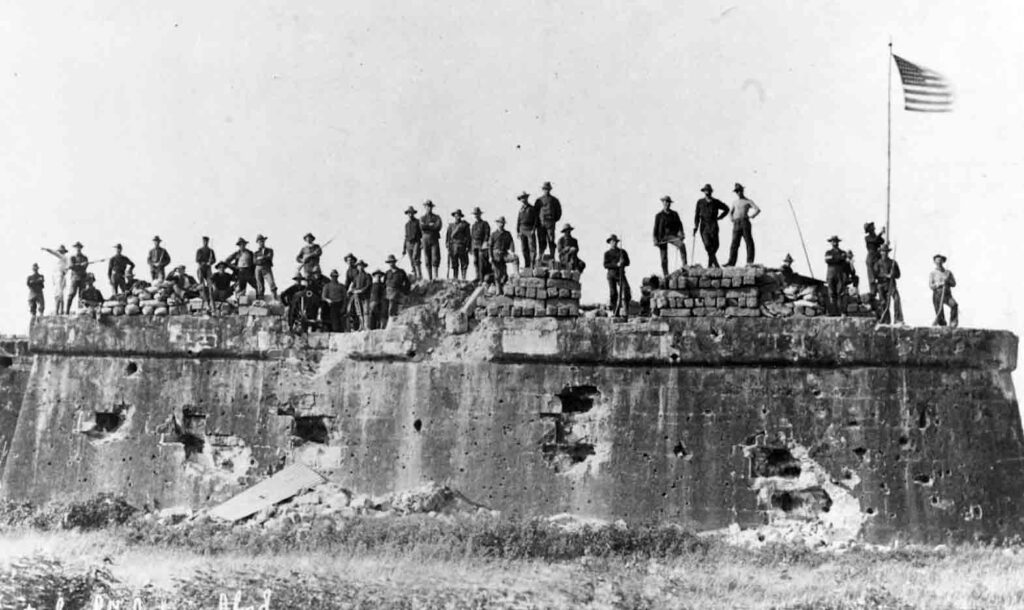The staged ‘Battle of Manila’ August 13, 1898

American soldiers after the mock Battle of Manila: The plan called for an American naval bombardment of Fort San Antonio Abad along Manila Bay for one hour.
August 1898 out started very heated and intense for the Philippines during the Spanish-American War. Following the Battle of Malate on July 31, 1898, the Spanish attacked the American lines south of Manila several more times over the next few days. Five more American soldiers died during these battles, and ten more were wounded.
The fighting between the Americans and the Spanish in Cuba had subsided by the middle of July. The United States Navy had decimated the Spanish fleet at Santiago de Cuba on July 3, 1898. The Spanish ground forces in Santiago could no longer count on Spanish naval support. The Spanish army at Santiago was compelled to surrender on July 17, 1898 to the American troops positioned on San Juan and Kettle Heights above Santiago. On the Cuban coastline in the vicinity of Havana, the United States Navy was maintaining an effective blockade.
The Spanish leadership in both Cuba and the Philippines knew that their days were numbered. Their defeat was inevitable. The Spanish Governor-General of the Philippines, Fermin Jaudenes, had replaced Governor-General Basilio Agustin y Davila at the end of July 1898. The Spanish leaders in Madrid were expecting a more vigorous response to the increasing American presence in the Philippines. By the end of July 1898, Governor-General Jaudenes knew that the Spanish position in Cuban was bleak and hopeless. He also knew that his situation in the Philippines was dire and not any better than Cuba.
Governor-General Jaudenes was placed in a very difficult predicament. He was well aware of the Spanish honor code for senior officers. A Spanish officer could not surrender or capitulate without a fight against the enemy. If the officer surrendered without a contest, he could be court-martialed for cowardice and/or other reasons when he returned to Spain.
Admiral George Dewey was well aware of Jaudenes struggles. In early August 1898, the two of them started formal negotiations through a third party on the terms of the Spanish surrender. Essentially the “Battle of Manila” would be a staged or a mock battle. The “battle” or the nominal American attack on Manila would provide Governor-General Jaudenes with an honorable surrender.
You may like: ‘Remember the Maine’ – the US rush to war with Spain in Feb. 1898
The initial timeline for the staged battle was August 7, 1898. This date was postponed until August 10 because the Spanish leader was concerned about the provisions for women, children, and wounded Spanish soldiers. The fake battle on August 10 was also delayed. Jaudenes had worries that Emilio Aguinaldo’s rebels would enter Manila and take retribution against their nemesis, the Spaniards. The Admiral Dewey informed him that the American ground forces would prevent the Filipino rebels from entering Manila.
Without another delay, August 13, 1898 at 9:35AM was designated as the date and time for the battle. The plan called for an American naval bombardment of Fort San Antonio Abad along Manila Bay for one hour. After the naval bombing, the American forces would enter Manila from their small section of the siege lines south of Manila. Initially, the advancing Americans marched along the beach on Manila Bay and then spread throughout the city.
At 11:20AM, Admiral Dewey could see the Spanish white flag flying over Intramuros or the old walled city of Manila. The American forces were successfully able to keep Aguinaldo’s forces out of Manila. By 5:43PM, American flags could be seen flying over large sections of Manila. The common American soldier had no inkling that the “Battle of Manila” was staged. Six American soldiers died during the fake fight and forty-three were wounded.
The unfortunate outcome of the staged battle was the complete breakdown of the American and Filipino alliance. Both parties woke up on the morning of August 13, 1898 thinking that they had at least a tenuous alliance with each other. But by late morning, there was not even a pretense of an alliance. The senior American officers had sold out Aguinaldo and his rebels. There was no Filipino representative at the formal surrender of Spain. Aguinaldo even feared that his former ally would arrest him if he entered Manila.
When the sun was setting on over Manila Bay on August 13, 1898, the siege lines and gates facing outside of Manila had a new occupant. The Spanish were gone and were now Prisoners of War. The Spanish were ordered to relinquish their weapons. The new soldiers in the entrenchments and gates facing the Filipino rebels were American troops. Ironically, in less than twenty-four hours, the strategic balance in the Philippines had changed dramatically. The allies had become each other’s enemy.
There was some additional irony about the staged “Battle of Manila.” Since the Spanish-American War in Cuba had essentially ended by mid-July 1898, there were efforts by the Americans and Spanish for an armistice until a formal treaty could be drafted. On August 12, 1898, United States President William McKinley had signed a peace protocol. The mock “Battle of Manila” was fought one day after the peace protocol was signed. Due to communication issues, the Americans in the Philippines did not hear about the armistice until August 16, 1898.
Dennis Edward Flake is the author of three books on Philippine-American history. He is Public Historian and a former seasonal park ranger in interpretation for the National Park Service at the Eisenhower National Historic Site in Gettysburg, PA. He can be contacted at: flakedennis@gmail.com

